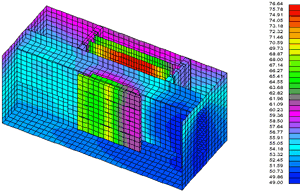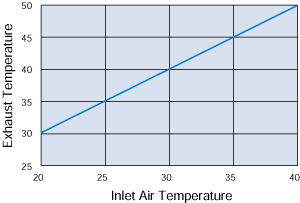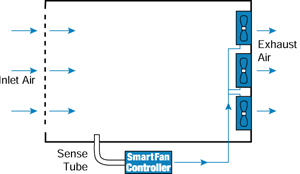Adaptive Cooling
What is Adaptive Cooling?
Operating a fan or blower at full speed continuously, or cycling it on and off, is a sub optimal solution in most cooling and ventilating applications. Ideally, the fan or blower should be controlled to operate at whatever speed is necessary to satisfy the need of the moment, no more and no less.
As shown in Figure 1 and Figure 2, the SmartFan cooling system senses environmental conditions such as temperature (air, surface or liquid), humidity or pressure and holds it nearly constant. A sensor connected to the SmartFan cooling system continually monitors the environmental condition. The SmartFan cooling product powers the air movers, automatically adjusting their speed over a predetermined range. A properly designed adaptive cooling or ventilation fan system will yield the following benefits.
- Noise Reduction
- Energy Savings
- Increased Fan Life
- Automatic Compensation for Changes in Cooling System Configuration
- Alarm Byproduct
- Other System Dependant Benefits
Noise Reduction
A significant advantage of adaptive cooling is the potential for considerable reduction in ventilation fan noise under normal environmental conditions. Most system designers select fans for the worst case conditions anticipated. This cooling product creates excessive, unnecessary fan noise in a normal environment.
Because there is a 5th power relation between noise level and fan speed, a small change in fan speed will cause a large change in fan noise. The equation for determining the noise level of a fan at less than full speed is given below:
| LS = L1 + 50 log S |
| S = Fan speed as a fraction of full fan speed |
| LS = A-weighted noise level at fan speed S |
| L1 = A-weighted noise level at full speed |
Example: A 300 CFM fan has a full speed noise rating of 59 dB(A).
What would the noise rating be at ½ full speed?
| L1/2 = 59 + 50 log (½) |
| L1/2 = 59 -15 |
| L1/2 = 44 dB(A) |
Energy Savings
A well designed adaptive cooling or ventilation system saves energy. By running the fans at reduced speed when less air flow is required, energy is saved. There is often an approximate square law relationship between fan speed and power consumption.
| Ps = P1(S)2 |
| S = Fan speed as a fraction of full fan speed |
| PS = Power consumption at a fan speed of S |
| P1 = Power consumption at full speed |
If a fan is running at a reduced speed under normal environmental conditions the potential for power saving is very high.
Example: A 1200 CFM blower uses 200 Watts of power at full speed. How much power would be required to run the blower at 600 CFM (1/2 speed)?
| P1/2 = 200(1/2)2 |
| P1/2 = 50 Watts |
Increased Fan Life
One of the most intriguing benefits of adaptive cooling and ventilation is its effect on system reliability. One might think that adding another feature to any system could only decrease its mean time between failure (MTBF). This is not the case with speed control.
Bearing failure, caused by heat and wear, is the most common cause of fan and blower failure. By allowing air movers to run at reduced speeds for much of the time, speed control actually increases fan life. Typical MBTF for speed control circuitry is between 106 and 107 hours. Typical fan MBTF is 105hours at full speed. The increased fan MBTF at reduced speeds significantly outweighs the negative impact of the addition of the control circuitry.
Automatic Compensation for Changes in Cooling System Configuration
Because SmartFan turns a flow-regulating device (a fan) into an environmental (temperature, humidity or pressure) regulating device, it will automatically adjust to changes in cooling system configuration such as:
- Changes in altitude
- Clogged, blocked or missing filters
- Single fan failure in a multiple fan system
- Opening and closing of windows and doors (HVAC application)
- Adding or removing circuit cards (electronics application)
- Fluctuations in voltage or frequency
- Variations in fan performance (fan choice less critical)
Alarm Byproduct
Since temperature, humidity or pressure must be continually monitored in adaptive cooling or ventilation applications, the cost of adding an alarm output to indicate abnormal environmental conditions is minimal. Sensors placed in one or more locations can monitor temperature, humidity or pressure and send a signal to light an LED, sound an audible alarm, trip a relay or send a logic signal.
Other System Dependent Benefits
In electronics applications, fluctuations of semiconductor junction temperatures are a major cause of component failure. By designing a closed loop cooling system around temperature and adding the proper temperature slope (sensor temperature at full speed – sensor temperature at idle speed), semiconductor junction temperatures can be held to near constant. As the air velocity over a typical semiconductor device changes by two-to-one, as it does when fan speed changes from full speed to half, the difference between the air temperature and junction temperature changes by a few degrees. Changing the air temperature by an equal number of degrees (3°C to 6°C for most off-the-shelf units) cancels this effect to hold absolute junction temperature near constant, improving product reliability.
For HVAC applications, controlling fans automatically to regulate environmental conditions saves energy, adds comfort and convenience, and reduces acoustical noise.
Adaptive Cooling System Design for Electronics
Balancing Benefits
The key to designing an effective adaptive cooling system for electronics applications is striking the right balance between reduced noise, energy savings, fan life, constant semiconductor junction temperatures vs. higher semiconductor junction temperatures at reduced fan speeds.
Cooling
Fan (air flow & pressure)
Enclosure Design (air flow path)
Heat Sources (power dissipation of devices)
Heatsinks (thermal resistance)
Using thermal analysis computer modeling early in the product design is vital in determining your cooling system variables. Contact CRI customer service for informantion reguarding thermal analysis services.

Click on image above for larger version.
Once these variables are established, the equipment’s temperature rise, Delta T can be determined.
Equipment Temperature Rise, Delta T = TE – TA1
TE = Exhaust temperature of equipment at full fan speed under normal operating conditions, ie: 20°C, sea level, clean filters, typical power usage.
TA1 = Ambient room temperature under normal operating conditions ie: 20°C, sea level, clean filters, typical power usage.
The temperature rise (or slope) of a particular fixed fan speed system will remain constant reguardless of the inlet air temperature. In Figure 4 below, the equipment temperature rise is 10°C

Figure 4
Click on image for larger version
Adding Variable Fan Speed to the Mix
To add variable fan speed to the mix, we need to determine what the slowest fan speed (idle speed) will be and what the Control Slope (sensitivity) TSwill be.
Idle speed should be set so that under normal operating conditions, semiconductor junction temperatures and fan noise levels are at a satisfactory level. Using computer modeling, semiconductor junction temperatures can be calculated at various fan speeds (noise levels). Consult MTBF and noise specifications as determined for your product.
If the goal is to maintain constant critical semiconductor junction temperatures, the Control Slope Ts should be equal to the temperature rise of semiconductor surface or junction temperatures between fan idle speed (as determined above) and full fan speed.
Now that these variables have been determined, one can calculate a Control Temperature.
Control Temperature Tc = The sensor (exhaust) air temperature above which fans run at full speed.
TC = TA2 + TS + (TE – TA1) / S
TA2 = The ambinent room temperature below which fans will run at the idle speed. To get maximum noise control benefits under normal environmental conditions, this temperature should be close to TA1 as determined above.
TS = Control Slope (sensitivity)
S = Fan idle speed as a percent of full speed.
Using the 10°C equipment temperature rise example above, selecting a 6°C control slope (TS), a 53% idle speed (S) and a 20°C ambient idle speed setting (TA2), we calculate a control temperature of 45°C and a control curve like the one illustrated in Figure 5 below.

Figure 5
Click on image for larger version
Alternate Method (sensing surface temperature)
The surface temperature of one or more critical semiconductors can be sensed and the fan speed can be varied to hold this temperature near constant.
To do this properly, the control slope must be as small as possible. We have found that a 3 – 4°C slope is about as low as one can go without introducing hystoresis or “hunting”. That is, fans would tend to constantly cycle up and down in speed “hunting” for an acceptable speed.
Adaptive Cooling and Ventilation for HVAC
Adaptive Cooling and Ventilation for HVAC
In HVAC cooling and ventilating applications such as;
- Clean Room Pressurization (pressure control)
- Attic, Whole House or Duct fans (temperature or pressure control)
- Livestock Ventilation (temperature control)
- Ceiling Fans (temperature control)
- Indoor Pools and Spas (humidity control)
- Locker Rooms and Bathrooms (humidity control)
- Industrial Equipment (temperature, humidity or pressure control)
SmartFan saves energy, reduces noise, increases fan life, compensates for changes in system configuration and provides the end user with the comfort and convenience of automatic control.
SmartFan® Alarms
Should an air mover in a cooling or ventilating application fail to operate properly, the results can be catastrophic. In electronics equipment, failure of an air mover may cause operational failure or even permanent damage. In ventilating applications, contaminants may build to dangerous levels, equipment may fail or livestock may perish.
Fan Speed Tach Alarms
Air mover speed is sensed using pulses generated by a Hall Effect device installed in the fan. Below a predetermined speed, an alarm is triggered. This method is very reliable, however it requires a special fan with a Hall Effect output. Because the Hall Effect device is part of any brushless DC fan, the output adds little cost. This feature may however add significant cost to an AC fan and may not be available on all models.
Temperature Alarms
Measuring temperature (air or surface) is fundamental. In combination with speed control it adds little cost because the sensor used to control speed can also provide a signal to the alarm circuitry. One disadvantage is a possible delay after air mover failure, before the alarm is triggered. A temperature or humidity alarm will of course also respond to failures other than the air mover. For example, operating equipment at excessive ambient temperature or with a clogged air filter could also trigger the alarm.
| Alarm Pros & Cons | |
| Fan Speed Tach Alarm | Temperature Alarm |
| No external sensor required | Sensor location critical |
| Quick response time | Slower response time |
| Can diagnose fan failure | Cannot diagnose fan failure |
| Requires fan with tach output | Uses normal fan |
| Will only signal fan failure | Will signal all types of thermal failure scenarios |
| Can be expensive in a multiple fan system | Economical (especially when used in conjunction with fan speed control) |
Alarm Outputs
Alarm outputs may be referenced to the negative terminal of a fan or can be optically isolated. In applications requiring higher switching (sinking) currents or voltages, the standard optical isolator can be replaced with a normally closed or normally open MOS relay. Alarms are available as an:
- Electrical signal to drive logic
- Visual signal (LED)
- Audible signal (piezo alarm)



